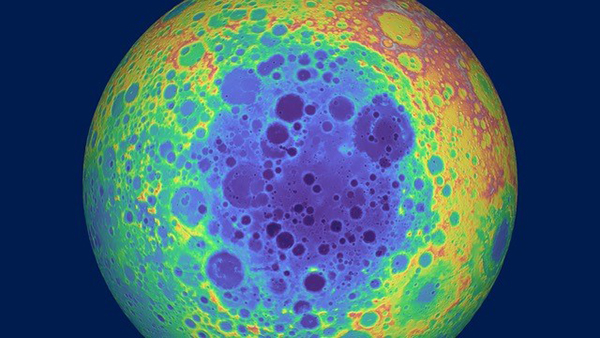Purdue planetary scientists may have solved the mystery of our Moon's South Pole-Aitken Impact Basin
09-25-2020
Writer(s): Cheryl Pierce

One of the mysteries our Earth’s moon has held is that some of the giant impact-generated basins we see do not behave the way scientists expected. It was once expected that impact basins should all be mass deficits as they are large holes in the ground; however, some of the larger lunar impact basins are instead mass concentrations, or mascons. Further adding to the mystery, all the largest impact basins except the largest and oldest basin, the South Pole-Aitken, are mascons. The formation of mascons and their apparent size dependence baffled scientists. That is, until now. Planetary scientists at Purdue University have solved this puzzle with their new publication in Icarus.
During the sixties, the moon was our next frontier. People around the world were in a space race to get to the moon. Before sending humans to the moon, NASA was sending uncrewed lunar orbiters on investigational missions. From 1966 to 1967, NASA sent five lunar orbiter missions to map the surface of the moon. These lunar orbiters were sent to help pick a landing space for Apollo missions. The obiters behaved in an unexpected manner when they approached these larger impact basins. It was expected that the orbiters would slow their velocity as they approached the massive basins that cover the moon. But instead, they sped up leading to the discovery of mascons.
Dr. Alexander Trowbridge, the lead author of this publication, recently graduated Purdue University and earned his PhD from the Department of Earth, Atmospheric, and Planetary Sciences. He and co-authors Dr. Brandon Johnson, Dr. Andrew Freed, and the late Dr. Jay Melosh, all professors of planetary sciences at Purdue University, created models to solve the apparent mascon size dependence. Thanks to NASA’s GRAIL mission to the Moon in 2014, of which Melosh was a coinvestigator, it was known that, unlike all smaller impact basins, the gigantic South-Pole Aitken Basin was not a mascon. The recent modeling revealed the reason for this puzzling difference. The modeling also indicates that the moon may have been weaker and hotter than what was previously believed at the time of impact.
“We modeled the full formation of South-Pole Aitken basin using a sequential two-code (hydrocode and Finite Element Model) approach to understand why this range does not extend to the largest lunar basin,” says Trowbridge. “Similar to previous work, we found that the best-fit hydrocode had impact parameters of a 170 km in diameter dunite projectile striking at 10 km/s, with a pre-impact lunar thermal gradient of 50 K/km (until a depth of 28 km at which an adiabat is reached), and pre-impact crustal thickness value of 40 km. Unlike previous work, we matched the crustal distribution of the inner basin by utilizing a weaker melt rheology in our model. Implying a weaker and hotter early Moon. The crust in the models with a weaker melt rheology flowed inward after crater collapse to cover the basin center; therefore, not requiring an additional step of melt differentiation. This has many implications for petrological modeling of crust formed from melt differentiation within the interior of basins.”
Their modeling explains that the South Pole-Aitken basin is too large and the lunar lithosphere was too thin at impact to create a mascon.
“Given the large diameter of South-Pole Aitken and the high geothermal gradient at impact, the steady state configuration after relaxation and thermal cooling was driven by isostatic forces without a significant contribution from lithospheric rigidity,” says Trowbridge. “Without lithospheric rigidity, South-Pole Aitken relaxed to a slightly negative free-air gravity signature, not forming a mascon, in agreement with GRAIL observations.”
This discovery helps mankind learn the history of the moon. Solving this mystery will get mankind one step closer to understanding the mysteries of our universe.
Hydrocode model of SPA video demonstrates what happens to the moon over time. On the left is plotted material versus the right is temperature. On the left, brown is mantle material and gray is crustal material. On the right, left is lowest temperature and red is higher. White lines show topography and crust/mantle boundary. Video credit: Dr. Andrew Trowbridge, Dr. Andrew Freed, Dr. Brandon Johnson, and Dr. Jay Melosh.